Design of Experiments Technique Applied to Artificial Neural Network Models for FPSO Mooring System Analysis
Abstract
:1. Introduction
2. Methodology
3. Case Study
4. Design of Experiments (DOE) for Supervised Feature Selection of Dataset
5. Machine Learning
5.1. Deep Learning
5.2. Hyperparameter Optimisation
5.3. Error Fitting and Evaluation
- –
- Mean absolute percentage error,
- –
- Mean squared error,
- –
- Root mean squared error,
- –
- Error,
- –
- Coefficient of determination,
5.4. Selection and Normalisation of Dataset
6. Results and Discussion
6.1. Mooring Tensions Prediction
6.2. FPSO Offset Chart Prediction
6.3. Discussion
7. Conclusions
Author Contributions
Funding
Institutional Review Board Statement
Informed Consent Statement
Data Availability Statement
Conflicts of Interest
References
- Banfield, S.; Casey, N. Evaluation of Fibre Rope Properties for Offshore Mooring. Ocean Eng. 1998, 25, 861–879. [Google Scholar] [CrossRef]
- Ma, K.-T.; Luo, Y.; Wu, Y. Mooring System Engineering for Offshore Structures; Elsevier: Amsterdam, The Netherlands, 2019; pp. 85–114. [Google Scholar] [CrossRef]
- Domingos, P. A few useful things to know about machine learning. Commun. ACM 2012, 55, 78–87. [Google Scholar] [CrossRef]
- Godoy Simoes, M.; Leonidas Merma Tiquilloca, J.; Mitio Morishita, H. Neural-network-based prediction of mooring forces in floating production storage and offloading systems. IEEE Access 2002, 38, 457–466. [Google Scholar] [CrossRef]
- Guarize, R.; Matos, N.A.F.; Sagrilo, L.V.S. Neural networks in the dynamic response analysis of slender marine structures. Appl. Ocean. Res. 2007, 29, 191–198. [Google Scholar] [CrossRef]
- Christiansen, N.H.; Torbergsen Voie, P.E.; Høgsberg, J.; Sødahl, N. Efficient Mooring Line Fatigue Analysis Using a Hybrid Method Time Domain Simulation Scheme. OMAE 2013, 1, T01A035. [Google Scholar] [CrossRef]
- De Pina, A.C.; De Pina, A.A.; Albrecht, C.H.; De Lima, B.S.; Jacob, B.P. ANN-based surrogate models for the analysis of mooring lines and risers. Appl. Ocean. Res. 2013, 41, 76–86. [Google Scholar] [CrossRef]
- De Pina, A.C.; De Pina, A.A.; Albrecht, C.H.; De Lima, B.S.; Jacob, B.P. Wavelet network meta-models for the analysis of slender offshore structures. Eng. Struct. 2014, 68, 71–84. [Google Scholar] [CrossRef]
- De Pina, A.C.; De Pina, A.A.; Albrecht, C.H.; De Lima, B.S.; Jacob, B.P. Artificial Neural Networks for the analysis of spread mooring configurations for floating production systems. Appl. Ocean. Res. 2016, 59, 254–264. [Google Scholar] [CrossRef]
- Sidarta, D.E.; Kyoung, J.; O’Sullivan, J.; Lambrakos, K.F. Prediction of Offshore Platform Mooring Line Tensions Using Artificial Neural Network. OMAE 2017, 1, T01A079. [Google Scholar] [CrossRef]
- Yetkin, M.; Kim, Y. Time series prediction of mooring line top tension by the NARX and Volterra model. Appl. Ocean. Res. 2019, 88, 170–186. [Google Scholar] [CrossRef]
- Zhao, Y.; Dong, S.; Jiang, F. Reliability analysis of mooring lines for floating structures using ANN-BN inference. J. Eng. Marit. Environ. 2020, 235, 236–254. [Google Scholar] [CrossRef]
- Zhao, Y.; Dong, S.; Jiang, F.; Incecik, A. Mooring tension prediction based on BP neural network for semisubmersible platform. Ocean Eng. 2021, 223, 108714. [Google Scholar] [CrossRef]
- Lee, D.; Lee, S.; Lee, J. Standardization in building an ANN-based mooring line top tension prediction system. Int. J. Nav. Archit. Ocean. Eng. 2022, 14, 100421. [Google Scholar] [CrossRef]
- Cotrim, L.P.; Barreira, R.A.; Santos Ismael, H.F.; Gomi, E.S.; Reali Co, A.H. Neural Network Meta-Models for FPSO Motion Prediction from Environmental Data With Different Platform Loads. IEEE Access 2022, 10, 86558–86577. [Google Scholar] [CrossRef]
- Li, P.; Jin, C.; Ma, G. Evaluation of Dynamic Tensions of Single Point Mooring System under Random Waves with Artificial Neural Network. J. Mar. Sci. Eng. 2022, 10, 666. [Google Scholar] [CrossRef]
- Lopez, J.T.; Tao, L.; Xiao, L.; Hu, Z. Experimental study on the hydrodynamic behavior of an FPSO in a deep water region of the Gulf of Mexico. J. Ocean. Eng. Technol. 2017, 129, 549–566. [Google Scholar] [CrossRef]
- DNVGL-RP-F205; Global Performance Analysis of Deep-water Floating Structures. Det Norske Veritas & Germanischer Lloyd (DNVGL): Oslo, Norway, 2020; pp. 7–28.
- Petrobras FPSOs Technical Specification. FPSO BRASIL: PETROBRAS P-52; PETROBRAS P-54; PETROBRAS P-55; PETROBRAS P-62. Available online: https://www.gov.br/ibama/pt-br (accessed on 12 February 2023).
- Montgomery, D.C. Design and Analysis of Experiments, 3rd ed.; Wiley: Hoboken, NJ, USA, 1991; Volume 22, Chapters 5–9; pp. 233–292. [Google Scholar] [CrossRef]
- Chakrabarti, S.K. Handbook of Offshore Engineering; Elsevier Science: Amsterdam, The Netherlands; Offshore Structural Analysis, Inc.: Plainfield, IL, USA, 2005; Volume 2. [Google Scholar]
- Metocean Data. Santos Basin Oil Export Studies. Santos Basin Central Cluster Region. Metocean Design Criteria. Technical Note and Specification. Available online: https://www.scribd.com/document/405828089/Metocean-Data-pdf (accessed on 15 March 2023).
- Aizenberg, I.; Aizenberg, N.N.; Vandewalle, J.P.L. Multi-Valued and Universal Binary Neurons: Theory, Learning and Applications; First Work to Introduce the Term “Deep Learning” to Neural Networks; Springer Science & Business Media: Berlin/Heidelberg, Germany, 2000. [Google Scholar]
- Schmidhuber, J. Deep Learning in neural networks: An overview. Neural Netw. 2015, 61, 85–117. [Google Scholar] [CrossRef] [PubMed]
- Menezes, J.M.P.; Barreto, G.A. Long-term time series prediction with the NARX network: An empirical evaluation. Neurocomputing 2008, 71, 3335–3343. [Google Scholar] [CrossRef]
- Rampasek, L.; Goldenberg, A. TensorFlow: Biology’s Gateway to Deep Learning? CellSystems 2016, 2, 12–14. [Google Scholar] [CrossRef] [PubMed]
- López, O.A.M.; López, A.M.; Crossa, J. Multivariate Statistical Machine Learning Methods for Genomic Prediction; Springer: Gewerbestrasse, Switzerland, 2022; Volume 1, Chapter 10; pp. 379–425. [Google Scholar] [CrossRef]
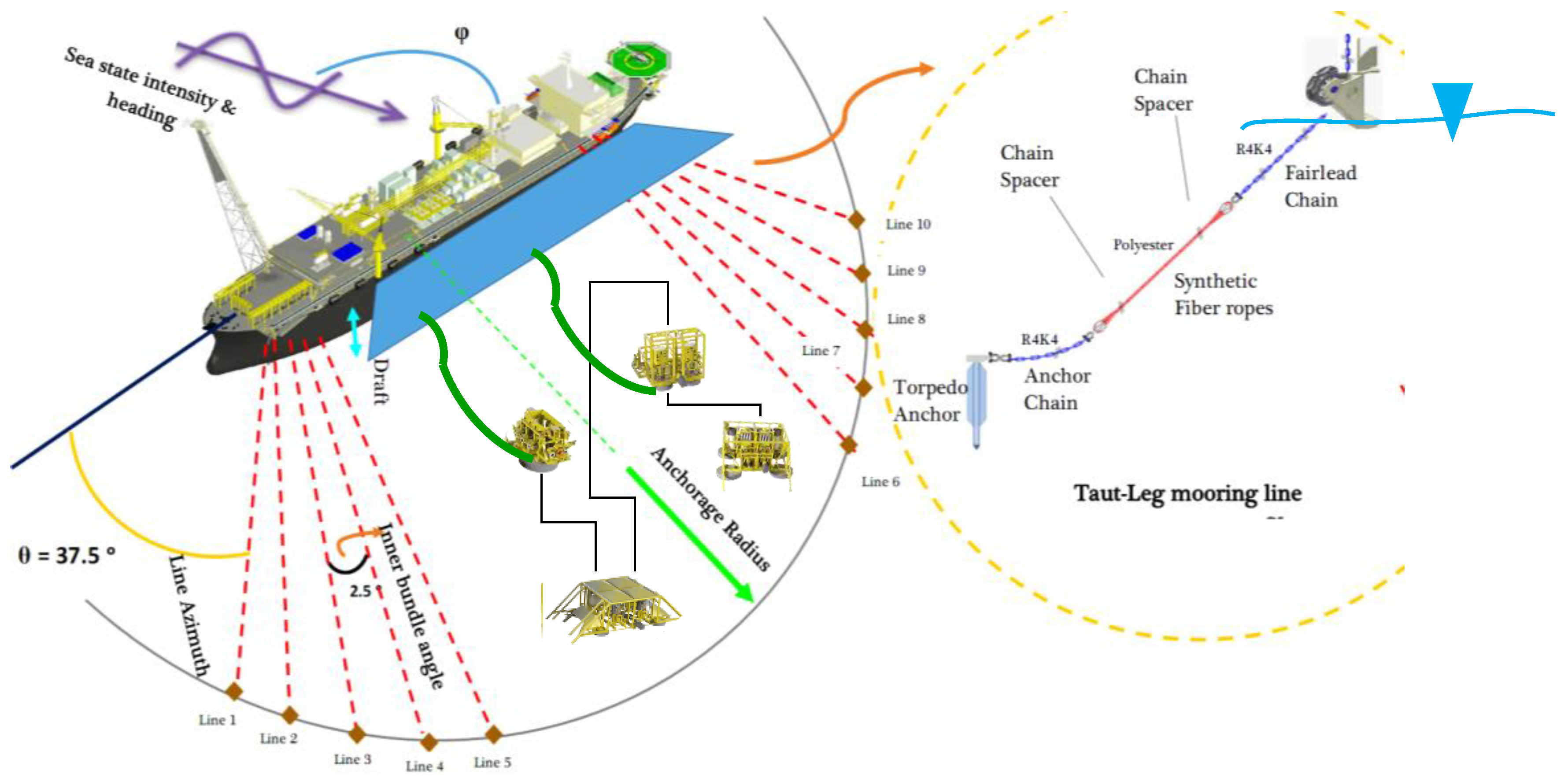
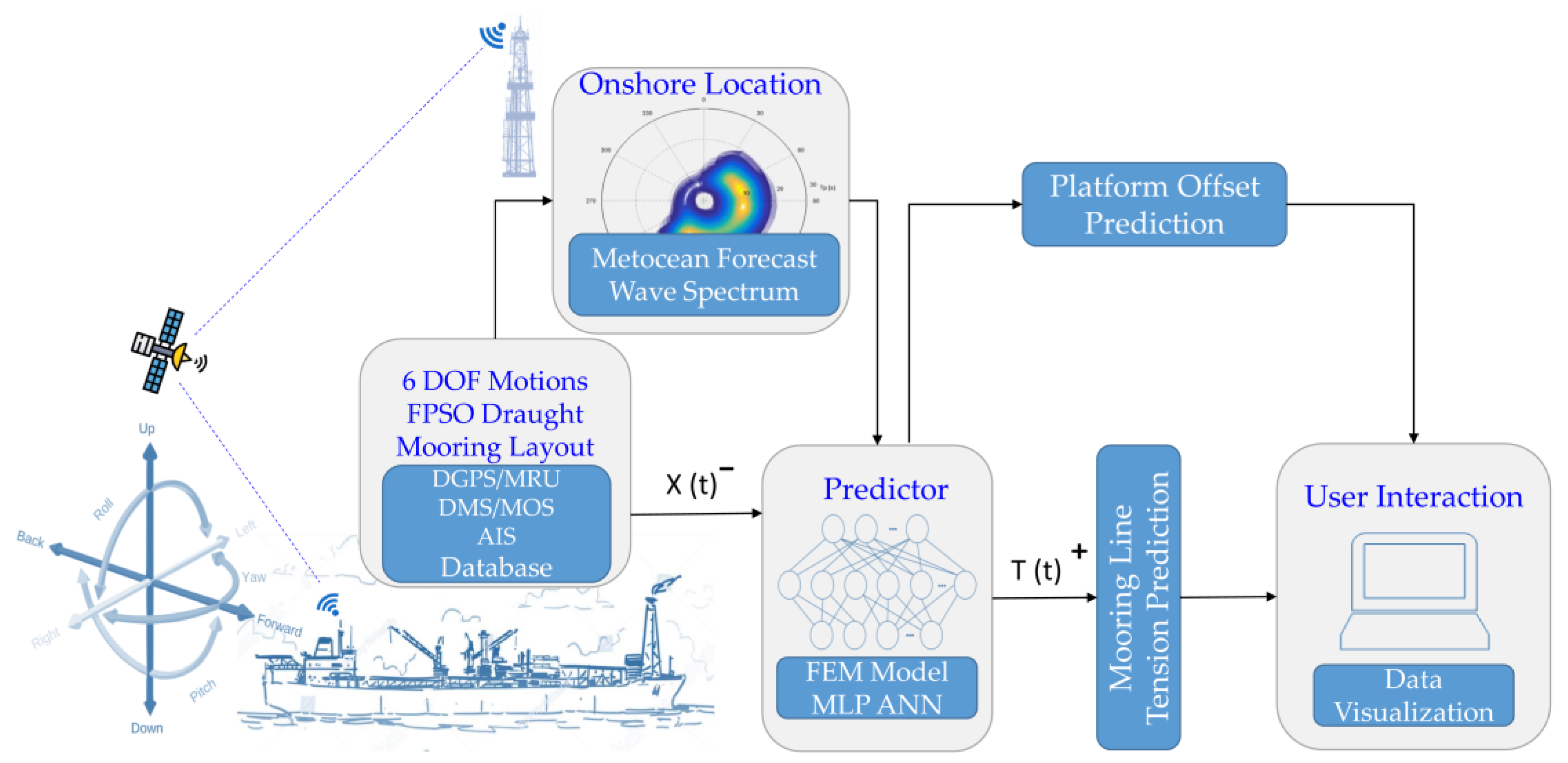
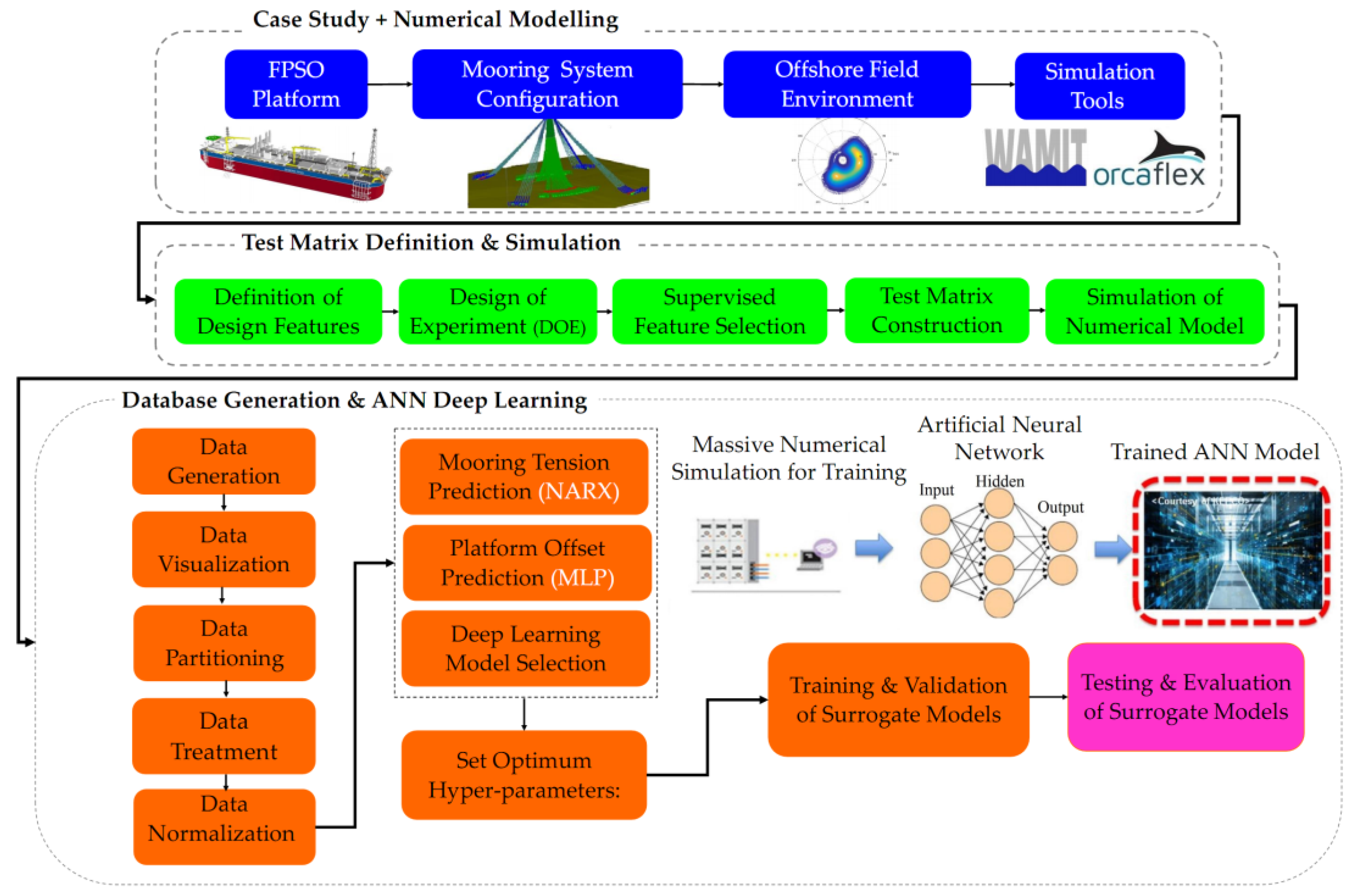
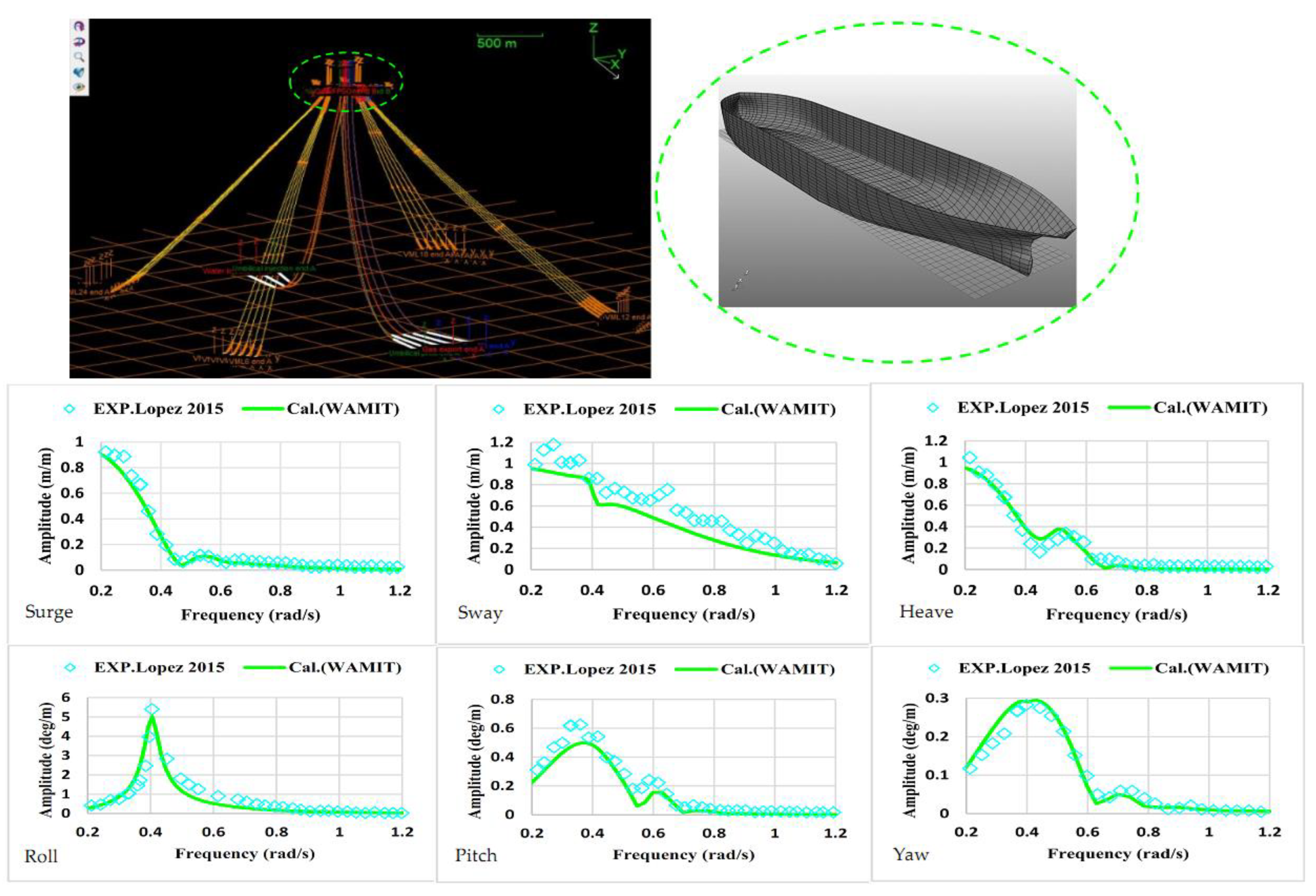


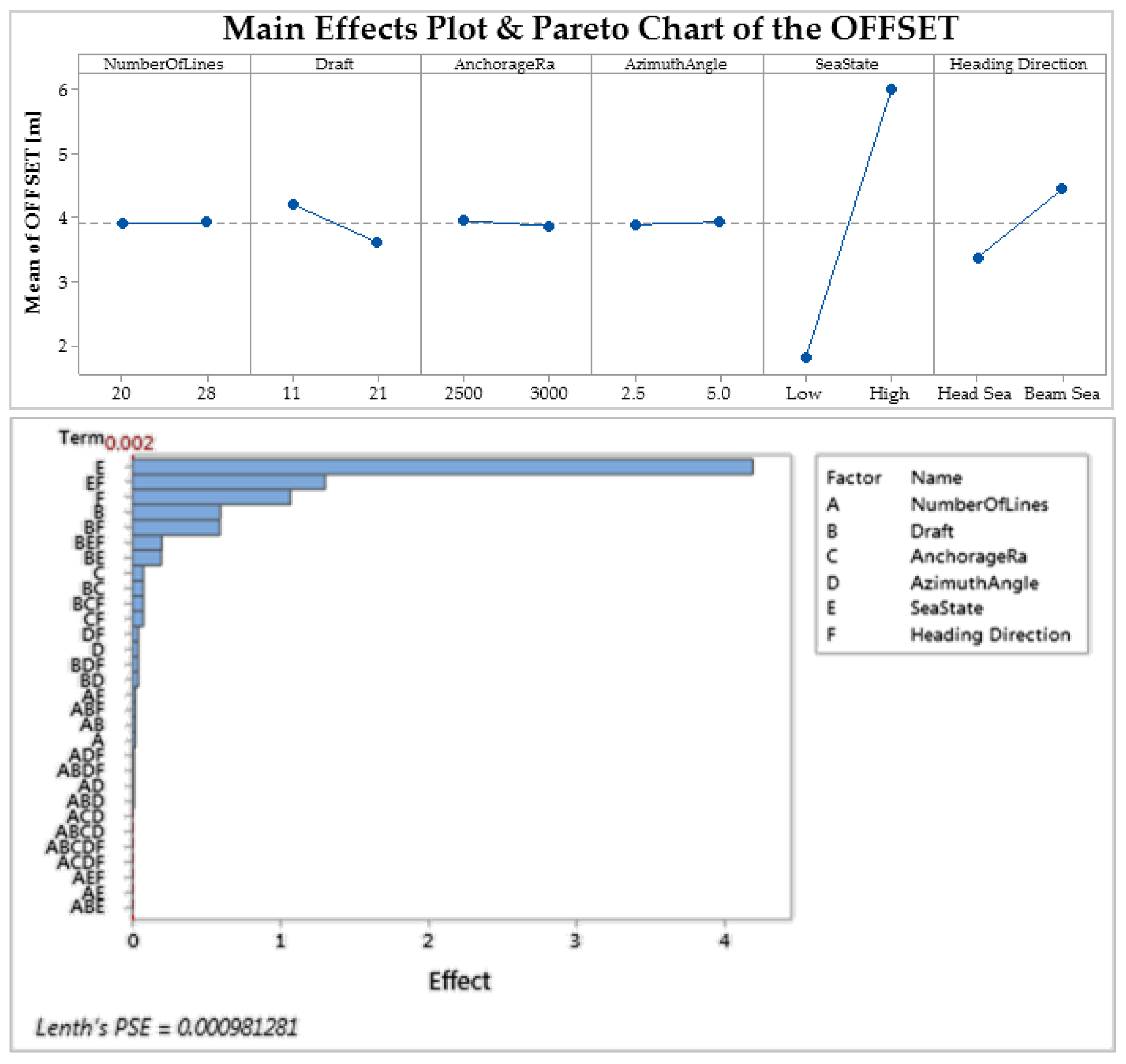
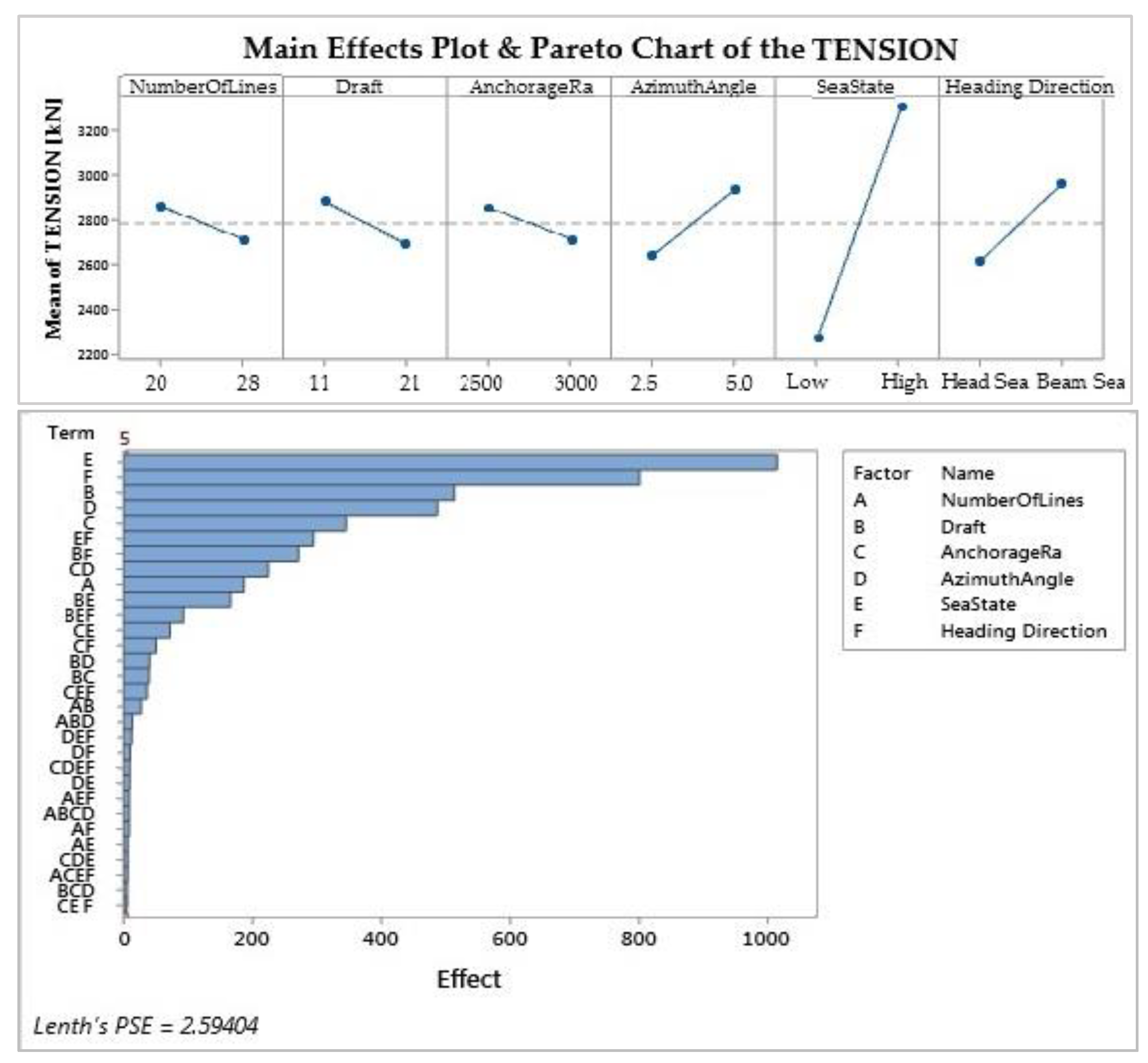
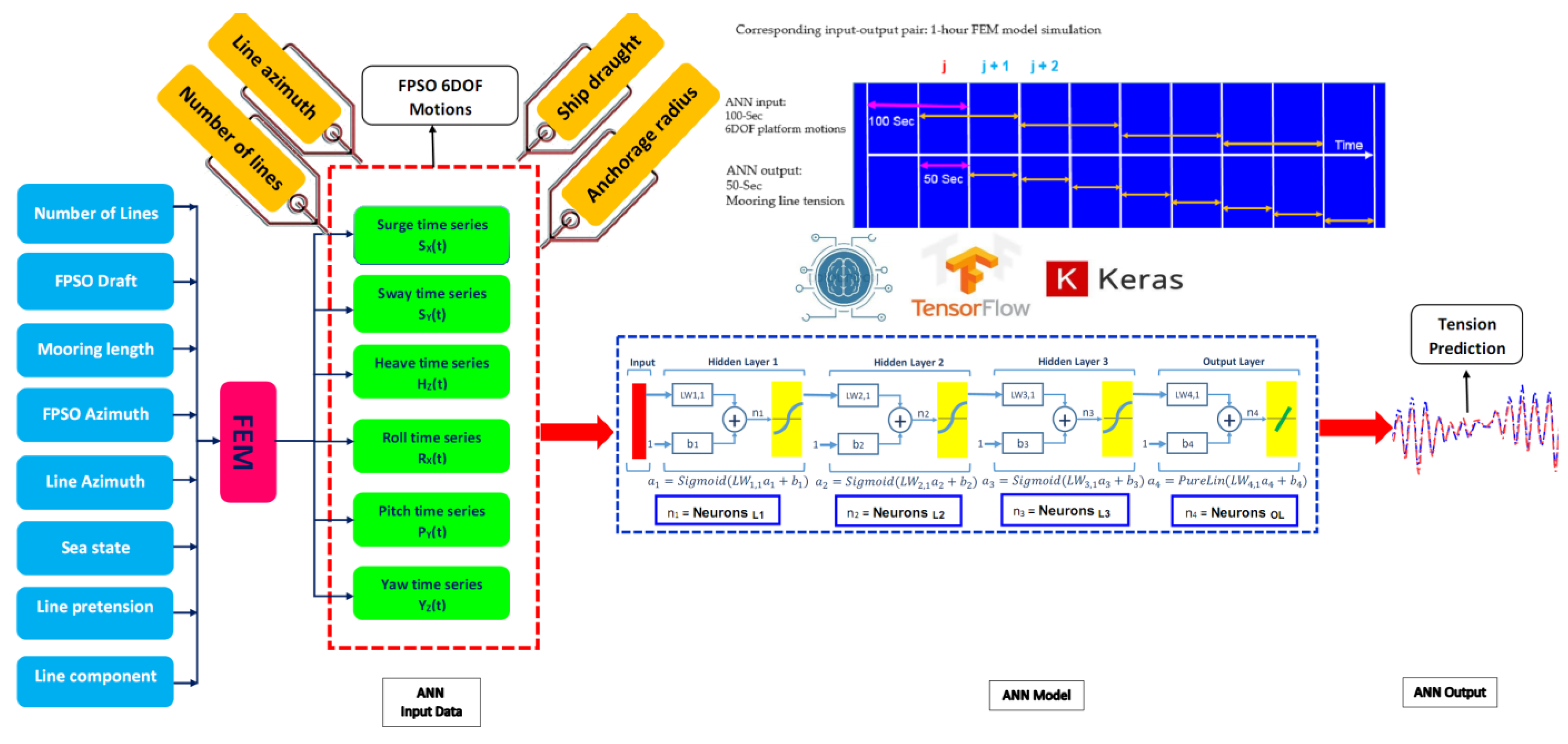
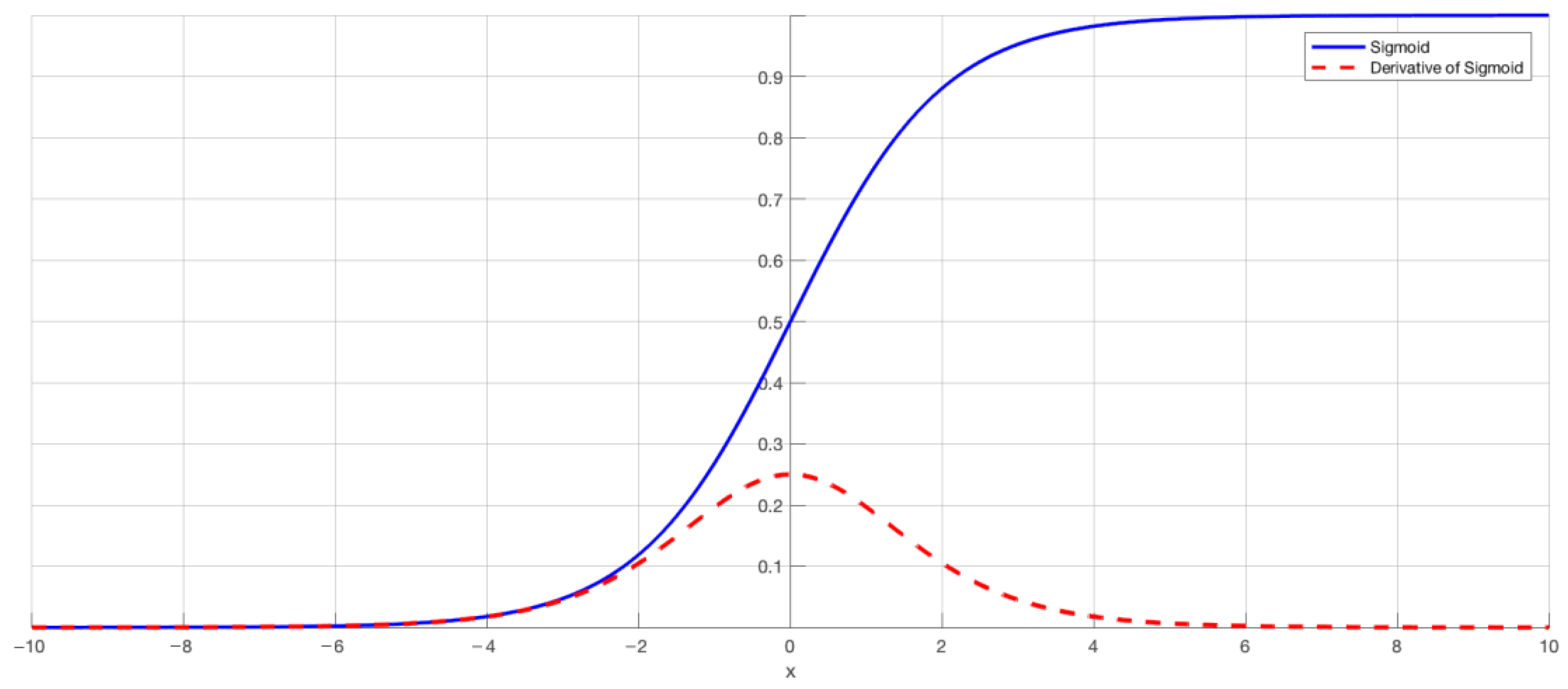



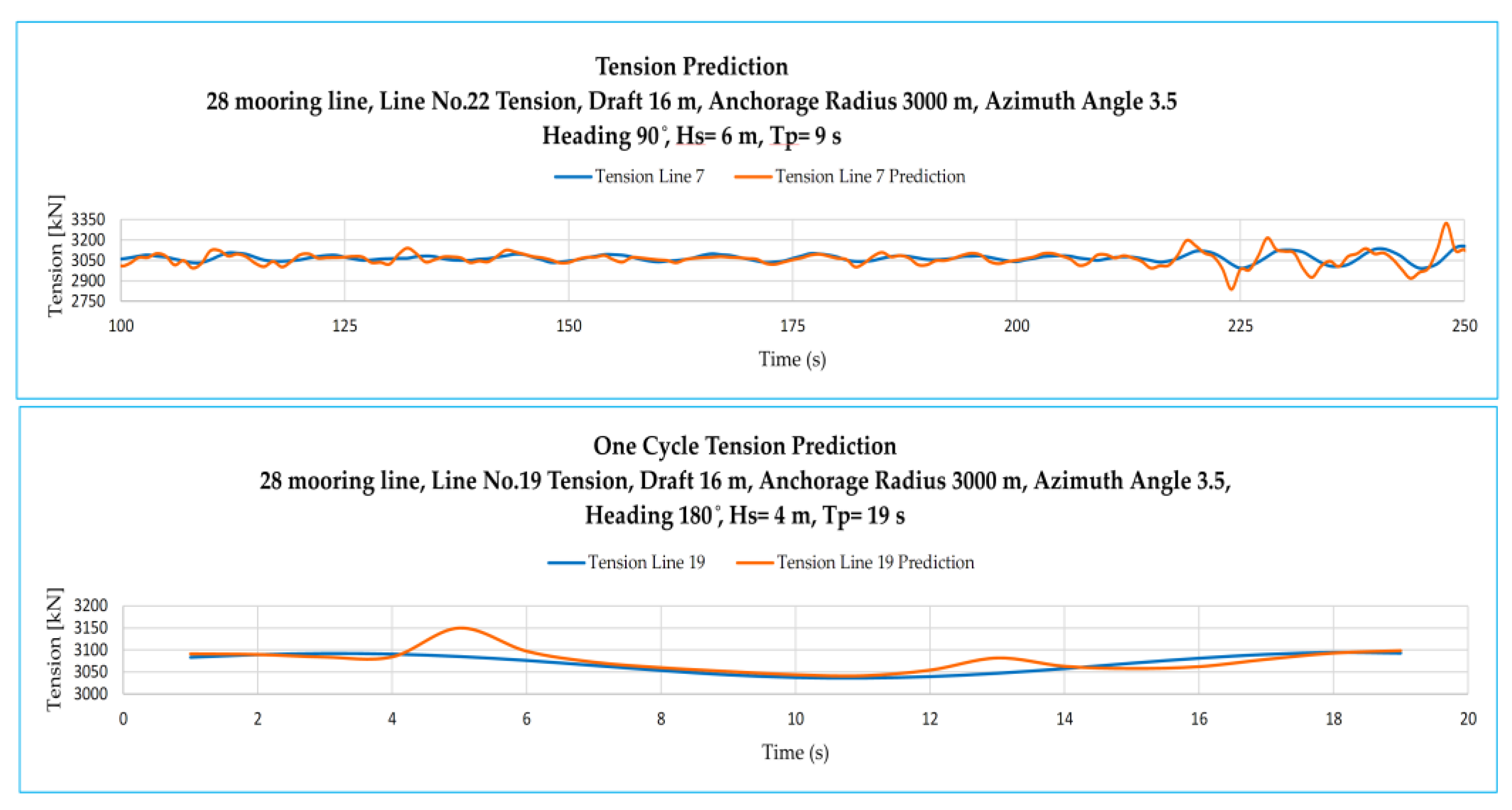
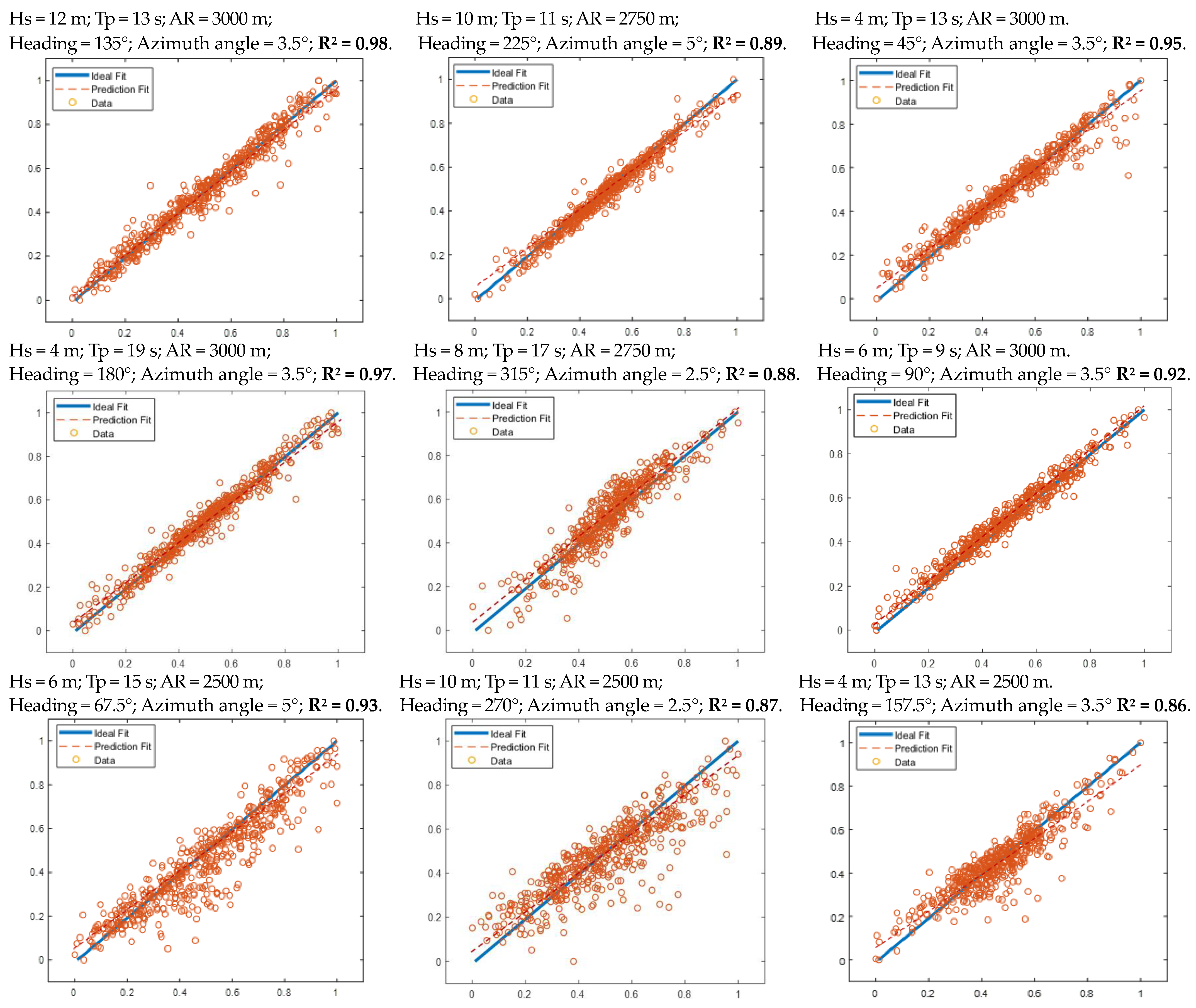
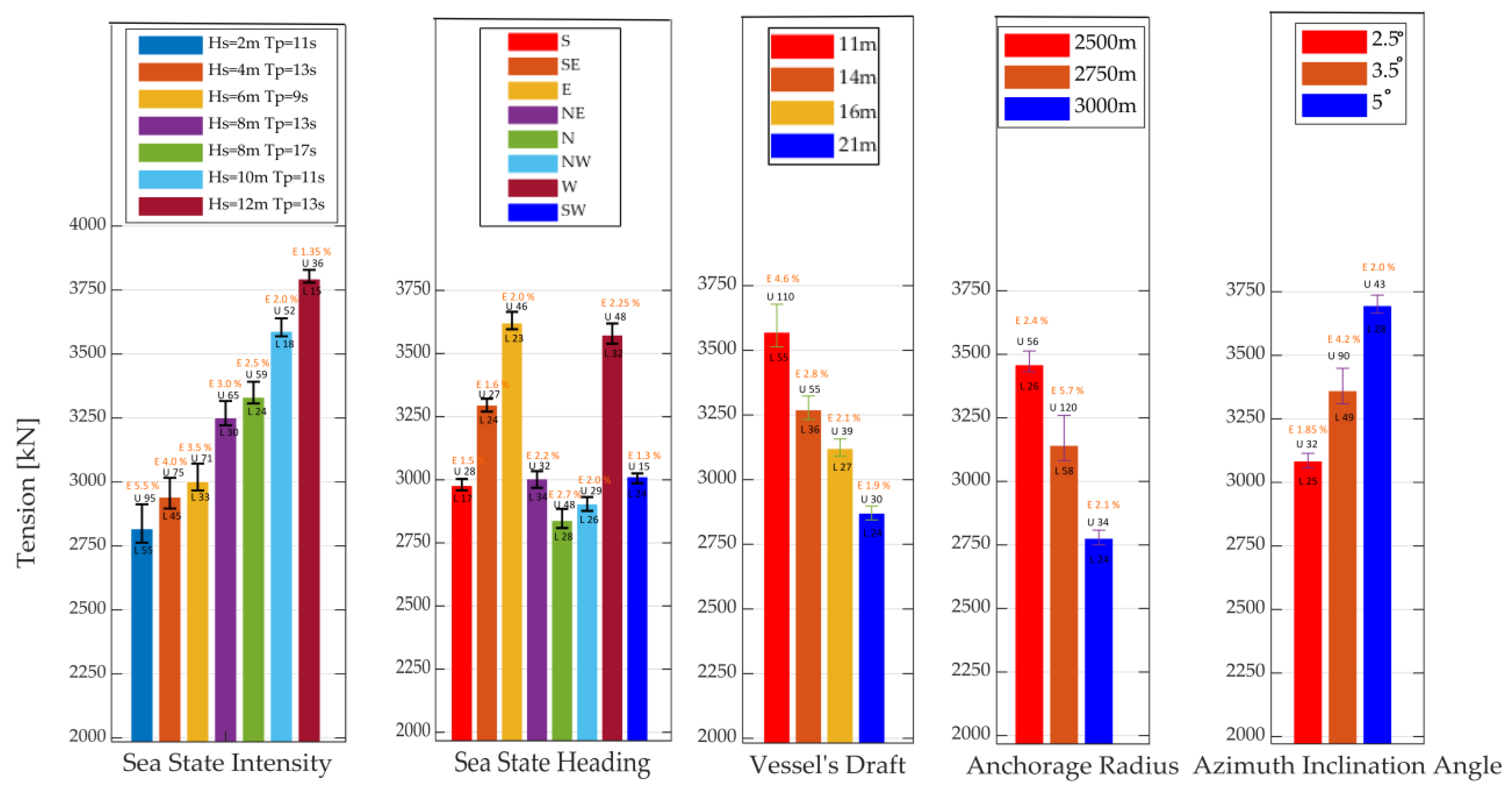
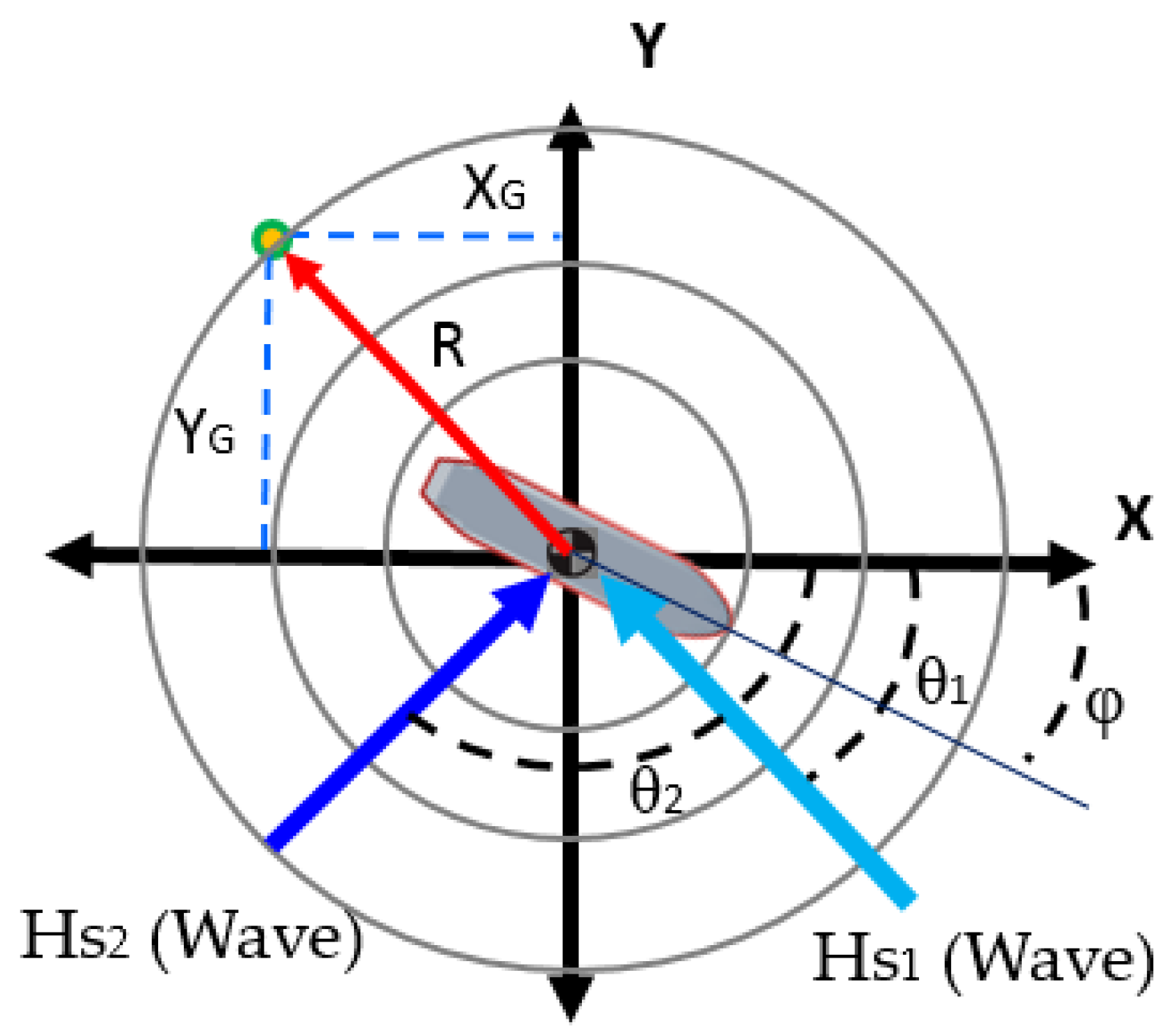


| Description | Loaded Condition | Ballast Condition |
|---|---|---|
| Length overall | 337.35 m | 337.35 m |
| Length B.P. | 320 m | 300 m |
| Breath | 54.6 m | 54.6 m |
| Depth | 27.8 m | 27.8 m |
| Ship draught | 21 m | 11 m |
| Longitudinal center of gravity | 144 m | 152 m |
| Vertical center of gravity | 16.7 m | 19.5 m |
| Mass radius of gyration in x axis | 16 m | 15 m |
| Mass radius of gyration in y axis | 80 m | 75 m |
| Mass radius of gyration in z axis | 80 m | 75 m |
| Operating Water Depth | 1500 m | 1500 m |
| Line N° | X (m) | Y (m) | Z (m) | Azimuth (degree) | Description | Magnitude | |||
|---|---|---|---|---|---|---|---|---|---|
| 1 | Cluster NW | 146 | 24 | 19 | 37.5 | Number of lines | 4 × 5 | ||
| 2 | 142 | 25 | 19 | 40 | Outer bundle angle | 37.5° | |||
| 3 | 138 | 26 | 19 | 42.5 | Inner bundle angle | 2.5° | |||
| 4 | 134 | 27 | 19 | 45 | Anchor radius | 2500 m | |||
| 5 | 130 | 28 | 19 | 47.5 | Segment (No) | Ønom (mm) | Material | Weight in water (kN/m) | |
| 6 | Cluster SW | −116 | 28 | 19 | 132.5 | 1 | 114 | R4K4 Chain | 2.238 |
| 7 | −120 | 27 | 19 | 135 | 2 | 225 | Polyester | 0.086 | |
| 8 | −124 | 26 | 19 | 137.5 | 3 | 114 | R4K4 Chain | 2.238 | |
| 9 | −128 | 25 | 19 | 140 | 4 | 225 | Polyester | 0.086 | |
| 10 | −132 | 24 | 19 | 142.5 | 5 | 114 | R4K4 Chain | 2.238 | |
| 11 | Cluster SE | −132 | −24 | 19 | 217.5 | 6 | 225 | Polyester | 0.086 |
| 12 | −128 | −25 | 19 | 220 | 7 | 120 | R4K4 Chain | 2.48 | |
| 13 | −124 | −26 | 19 | 222.5 | Segment (No) | EA 1 (kN) | Length (m) | MBL 2 (kN) | |
| 14 | −120 | −27 | 19 | 225 | 1 | 919,077 | 350 | 12,420.4 | |
| 15 | −116 | −28 | 19 | 227.5 | 2 | 206,010 | 900 | 13,734 | |
| 16 | Cluster NE | 130 | −28 | 19 | 312.5 | 3 | 919,077 | 10 | 12,420.4 |
| 17 | 134 | −27 | 19 | 315 | 4 | 206,010 | 900 | 13,734 | |
| 18 | 138 | −26 | 19 | 317.5 | 5 | 919,077 | 10 | 12,420.4 | |
| 19 | 142 | −25 | 19 | 320 | 6 | 206,010 | 500 | 13,734 | |
| 20 | 146 | −24 | 19 | 322.5 | 7 | 982,080 | 200 | 13,573 | |
| Surge | Sway | Heave | Roll | Pitch | Yaw | |
|---|---|---|---|---|---|---|
| DNV-GL FPSO | >100 (S) | >100 (S) | 5–12 (S) | 5–30 (S) | 5–12 (S) | >100 (S) |
| Original FPSO | 265 (S) | 225 (S) | 11 (S) | 14 (S) | 10 (S) | 155 (S) |
| Numerical Model | 250 (S) | 212 (S) | 12 (S) | 14 (S) | 10 (S) | 150 (S) |
| Attributes | Level Low −1 | Level High +1 | Test Runs | ||||||||
|---|---|---|---|---|---|---|---|---|---|---|---|
| Number of lines | 20 | 28 | 20, 28 | 2 | |||||||
| FPSO draft (m) | 11 | 21 | 11, 14, 16, 21 | 2 | |||||||
| Anchorage Radius (m) | 2500 | 3000 | 2500, 2750, 3000 | 2 | |||||||
| Line Azimuth Angle (°) | 2.5 | 5 | 2.5°, 3.5°, 5° | 2 | |||||||
| Line Pre-tension (kN) | Cluster NW | 1950 | Combination 1 | 1850 | Combination 2 | 2 | |||||
| Cluster SW | 1750 | 1650 | |||||||||
| Cluster NE | 2000 | 1900 | |||||||||
| Cluster SE | 2050 | 1950 | |||||||||
| Santos Basin Offshore Brazil Wave Scatter Diagram [22] | |||||||||||
| Sea State (Hs/Tp) (m/S) | 3 | 5 | 7 | 9 | 11 | 13 | 15 | 17 | 19 | 21 | |
| 2 | X | X | O | X | X | X | X | X | X | X | 8 |
| 4 | O | X | X | X | □ | X | X | O | |||
| 6 | X | □ | O | X | □ | X | |||||
| 8 | X | X | O | X | □ | ||||||
| 10 | □ | X | X | O | |||||||
| 12 | □ | O | |||||||||
| 16 | O | ||||||||||
| Sea State Heading (°) | N | NE | E | SE | S | SW | W | NW | 8 | ||
| 180° | 135° | 90° | 45° | 0° | 315° | 270° | 225° | ||||
| Parameter | Mooring Tension | Platform Offset |
|---|---|---|
| The number of hidden layers | 3 | 3 |
| The number of neurons in each layer | 611, 3 × 1222, 50 | 6, 18, 24, 18, 1 |
| Activation function between hidden layers | Sigmoid | ReLU |
| Activation function before output layer | Linear | Linear |
| Loss function | M S E | M S E |
| Batch size | 100 | 100 |
| The number of epochs | 100 | 100 |
| Optimizer | Adam | Adam |
| Learning Rate | 0.001 | 0.001 |
| 0.9 | 0.9 | |
| 0.999 | 0.999 | |
| 1.0 × 10−8 | 1.0 × 10−8 | |
| Learning Rate Decay | 0.0 | 0.0 |
| Samples | Number of Lines (No.) (S) | Azimuth Inclination (Deg.) (S) | Anchorage Radius (m) (S) | Draft (m) (S) | Surge (m) (D) | Sway (m) (D) | Heave (m) (D) | Roll (Deg.) (D) | Pitch (Deg.) (D) | Yaw (Deg.) (D) | Tension (kN) (D) |
|---|---|---|---|---|---|---|---|---|---|---|---|
| 1 | 20 | 5 | 2500 | 11 | 1.85 | −4.53 | 4.24 | −7.32 | −2.82 | 1.19 | 3096.62 |
| 2 | 28 | 5 | 2500 | 11 | −1.67 | 2.614 | −1.72 | 1.11 | 0.73 | −0.446 | 2699.09 |
| • | • | • | • | • | • | • | • | • | • | • | • |
| • | • | • | • | • | • | • | • | • | • | • | • |
| • | • | • | • | • | • | • | • | • | • | • | • |
| 3445K | 20 | 2.5 | 3000 | 21 | 2.1 | −1.4846 | 1.121 | −1.4753 | 3.0961 | 0.3613 | 2242.47 |
| 3446K | 28 | 2.5 | 3000 | 21 | −1.67 | 0.6134 | −1.7188 | 1.1088 | 0.7298 | −0.4462 | 1829.49 |
| Test Runs | HS1 (m) (D) | TP1 (s) (D) | θ1 (°) (S) | HS2 (m) (D) | TP2 (s) (D) | θ2 (°) (S) | φ (°) (S) | Draft (m) (S) |
|---|---|---|---|---|---|---|---|---|
| 1 | 1.3 | 4 | 0 | 0.6 | 4.8 | 90 | 0–355 | 11 |
| 2 | 2.1 | 4.5 | 45 | 1 | 7.7 | 135 | 0–355 | 11 |
| • | • | • | • | • | • | • | • | • |
| • | • | • | • | • | • | • | • | • |
| • | • | • | • | • | • | • | • | • |
| 13,319 | 5.3 | 17 | 180 | 2.2 | 7.9 | 90 | 0–355 | 21 |
| 13,320 | 9.8 | 17.5 | 225 | 3.1 | 10.4 | 135 | 0–355 | 21 |
| Variables | HS (m) | TP (s) | θ (°) | R2 | MAPE | MAE | RMSE | Ten_FEM (Max.) | Ten_ANN (Max.) | E (%) |
|---|---|---|---|---|---|---|---|---|---|---|
| 2 | 11 | N | 0.924 | 0.005 | 15 | 20 | 2046 | 2052 | 0.2 | |
| 4 | 13 | NE | 0.954 | 0.004 | 12 | 16 | 2456 | 2463 | 0.2 | |
| 6 | 9 | E | 0.917 | 0.006 | 19 | 25 | 2844 | 2835 | 0.3 | |
| 6 | 15 | SE | 0.926 | 0.005 | 15 | 20 | 3287 | 3279 | 0.2 | |
| 8 | 13 | S | 0.911 | 0.006 | 19 | 25 | 3517 | 3527 | 0.3 | |
| 8 | 17 | SW | 0.978 | 0.003 | 8 | 11 | 3507 | 3512 | 0.1 | |
| 10 | 11 | W | 0.877 | 0.009 | 25 | 30 | 3625 | 3617 | 0.2 | |
| 12 | 13 | NW | 0.985 | 0.002 | 6 | 10 | 3724 | 3720 | 0.1 | |
| 2 | 11 | N | 0.891 | 0.0085 | 27 | 38 | 1981 | 1998 | 0.8 | |
| 4 | 13 | NE | 0.899 | 0.008 | 25 | 37 | 2063 | 2077 | 0.6 | |
| 6 | 9 | E | 0.812 | 0.019 | 53 | 66 | 2544 | 2500 | 1.7 | |
| 6 | 15 | SE | 0.871 | 0.012 | 31 | 42 | 3140 | 3107 | 1 | |
| 8 | 13 | S | 0.829 | 0.018 | 49 | 58 | 3376 | 3358 | 0.5 | |
| 8 | 17 | SW | 0.883 | 0.011 | 28 | 39 | 3351 | 3332 | 0.6 | |
| 10 | 11 | W | 0.828 | 0.018 | 49 | 58 | 3453 | 3484 | 0.9 | |
| 12 | 13 | NW | 0.897 | 0.008 | 24 | 25 | 3567 | 3539 | 0.8 | |
| 2 | 11 | N | 0.967 | 0.0035 | 10 | 14 | 1950 | 1955 | 0.25 | |
| 4 | 13 | NE | 0.988 | 0.0015 | 4 | 7 | 2240 | 2237 | 0.1 | |
| 6 | 9 | E | 0.931 | 0.0045 | 13 | 18 | 2418 | 2424 | 0.2 | |
| 6 | 15 | SE | 0.989 | 0.0015 | 4 | 6 | 2826 | 2828 | 0.07 | |
| 8 | 13 | S | 0.974 | 0.003 | 8 | 11 | 3039 | 3036 | 0.1 | |
| 8 | 17 | SW | 0.981 | 0.002 | 6 | 10 | 3166 | 3163 | 0.09 | |
| 10 | 11 | W | 0.945 | 0.004 | 12 | 16 | 3446 | 3443 | 0.08 | |
| 12 | 13 | NW | 0.989 | 0.0015 | 4 | 6 | 3673 | 3675 | 0.05 |
Disclaimer/Publisher’s Note: The statements, opinions and data contained in all publications are solely those of the individual author(s) and contributor(s) and not of MDPI and/or the editor(s). MDPI and/or the editor(s) disclaim responsibility for any injury to people or property resulting from any ideas, methods, instructions or products referred to in the content. |
© 2023 by the authors. Licensee MDPI, Basel, Switzerland. This article is an open access article distributed under the terms and conditions of the Creative Commons Attribution (CC BY) license (https://creativecommons.org/licenses/by/4.0/).
Share and Cite
Nikkhah, E.; Fernandes, A.C.; Caprace, J.-D. Design of Experiments Technique Applied to Artificial Neural Network Models for FPSO Mooring System Analysis. J. Mar. Sci. Eng. 2023, 11, 2194. https://doi.org/10.3390/jmse11112194
Nikkhah E, Fernandes AC, Caprace J-D. Design of Experiments Technique Applied to Artificial Neural Network Models for FPSO Mooring System Analysis. Journal of Marine Science and Engineering. 2023; 11(11):2194. https://doi.org/10.3390/jmse11112194
Chicago/Turabian StyleNikkhah, Ehsan, Antonio Carlos Fernandes, and Jean-David Caprace. 2023. "Design of Experiments Technique Applied to Artificial Neural Network Models for FPSO Mooring System Analysis" Journal of Marine Science and Engineering 11, no. 11: 2194. https://doi.org/10.3390/jmse11112194
APA StyleNikkhah, E., Fernandes, A. C., & Caprace, J.-D. (2023). Design of Experiments Technique Applied to Artificial Neural Network Models for FPSO Mooring System Analysis. Journal of Marine Science and Engineering, 11(11), 2194. https://doi.org/10.3390/jmse11112194









